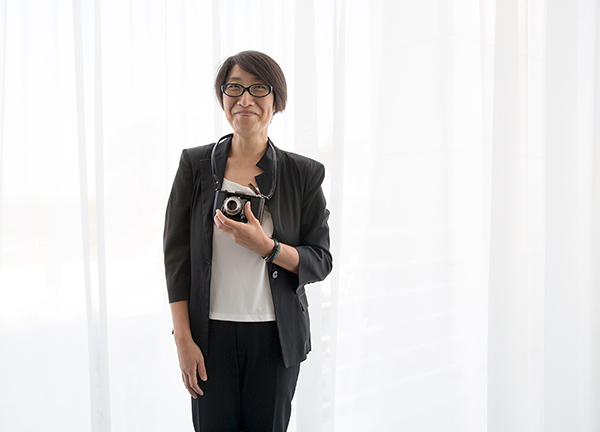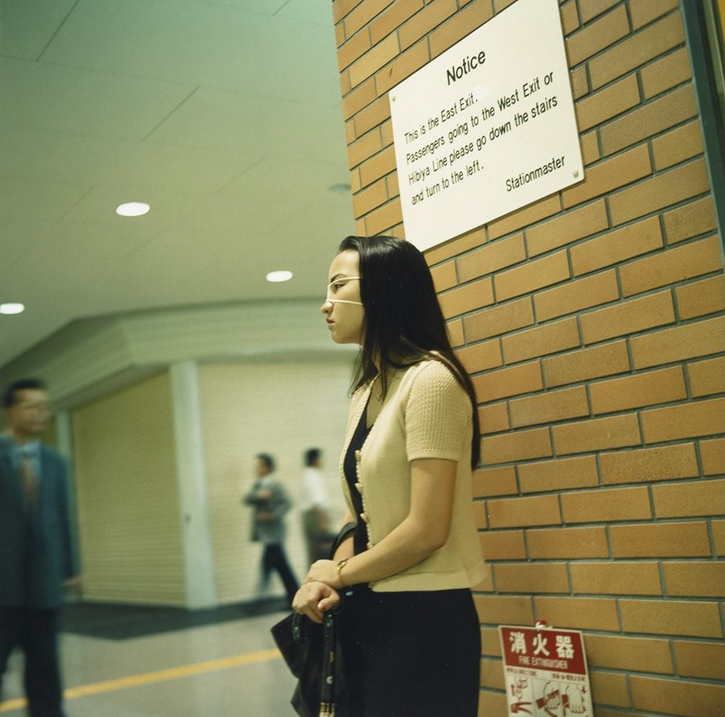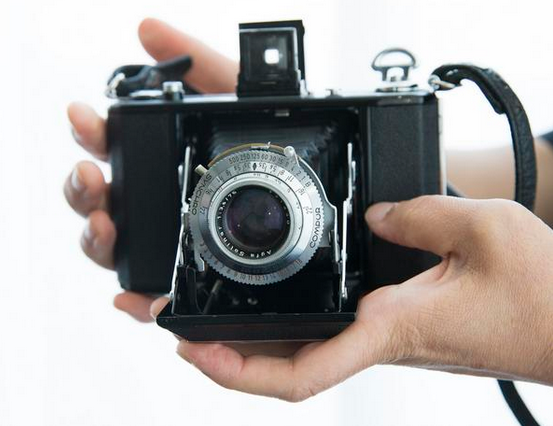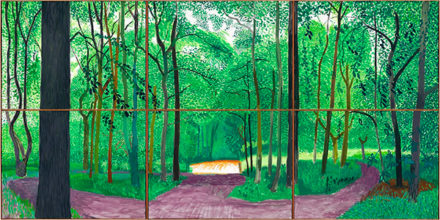Mikiko Hara is the youngest of the four featured Japanese photographers in the exhibition In Focus: Tokyo. She has been photographing since the early 1990s, and since 1995 has been shooting with the same vintage camera. The subjects in the photographs find her—she photographs people, landscapes, and moments coming and going, on the verge of disappearing. Her images feel timeless and placeless, as if these memories could be anybody’s.

At the master class, Mikiko makes my portrait as I take hers. This is how she holds the camera in the street.
Mikiko was recently Los Angeles to teach a master class hosted by the Getty Museum’s Education Department as part of an ongoing partnership between the Museum and community colleges. These master classes offer student photographers unique opportunities to hear from photographers whose work is featured at the Getty and often inform larger projects undertaken by the students with the guidance of their instructors. We look forward to seeing some snapshots in the Hara style from students at Pierce College, East Los Angeles College, and College of the Canyons.
While visiting Los Angeles, Hara also stopped in at Giant Robot in Little Osaka (on Sawtelle Blvd. on the Westside) to sign books and talk about her work, and also discussed her approach to photography with a different audience at The Japan Foundation. She brought her prized camera on the trip and generously shared her story and approach to photography.
Tokyo’s Streets and Subways
Mikiko has lived in Tokyo for 20 years. And while her subjects vary, her technique does not. When shooting, she forms a secret relationship with the people she photographs—who usually aren’t aware of her presence. As she wanders the streets and subways of Tokyo, she waits for an urge or intuitive push to capture the scene. With the camera hanging from her neck, quiet shutter cocked, she guesstimates focal distance and then fires. A state of blankness is important to her process, as she seeks to capture the moment before her subject’s story can be reduced to words. In this, she strives to create tangible photographic pieces capturing a universal feeling.

Untitled (Is As It), negative 1996; print about 2007, Mikiko Hara. Chromogenic print, 14 x 14 in. The J. Paul Getty Museum. Purchased with funds provided by the Photographs Council, 2008.8.1. © Mikiko Hara
Taking photographs without looking through the viewfinder allows for three things. First, she can overcome the fear she feels in making portraits in the streets. Second, she doesn’t know the result of the image at the time of taking it. And third, by ignoring the framed viewfinder, she is present in the scene.
She didn’t always practice photography in this experimental, chance-based way. She reached this way of shooting after two rigorous years studying at Tokyo College of Photography.
At this school, the rules of photography were very rigid, as she explained:
You must photograph the street. You must photograph with light coming from behind you. Don’t make dramatic photographs. Don’t photograph pretty children or beautiful old ladies, they are too photogenic and make your job too easy. Don’t center your subject.
Mikiko was apprehensive about the quality of this education. But in this period, she was shooting 800 rolls of film per year—28,800 exposures a year. She was also working in the darkroom and making prints. But even then she wasn’t sure if photography was for her.

Mikiko Hara’s camera. The body is German, made by Ikonta in the 1930s. A friend fixed on the lens, made in the 1950s. The camera is light, and the shutter is quiet.
It wasn’t until later, when she was gifted a copy of Garry Winogrand’s Figments from the Real World, that photography finally made sense to her. She had always strongly felt that the camera had a truer and harsher vision of the world than her own eyes. As Winogrand famously said, “I photograph to find out what something will look like photographed.”
Feelings Too Complex for Words
Mikiko spent two years learning the rules, and two years unlearning the rules. This “period of struggle,” as she calls it, was a time where she experimented with black and white, color, different films, new formats, and new modes of working.
The camera she uses informs her process and style. It’s quiet. It’s discreet. Many people don’t even recognize it as a camera today. And she has been shooting this way ever since she made that connection.
Mikiko feels that the camera is not a good tool to illustrate the thoughts of the photographer. Rather, the camera captures things in a clear manner, things that might not be clear at all to our eyes. In this way, she’s collecting answers with the camera. Answers to universal feelings and questions that make looking at her photographs a familiar process, one of déjà vu and reflection. As people we have complex feelings, often too complex to describe with words. Her photographs operate in this space. Indescribable, powerful, familiar, and beautiful.
_______
In Focus: Tokyo is on view at the Getty Center through December 14, 2014.
Special thanks to Kio Griffith for interpreting for Mikiko and the master class participants.




Comments on this post are now closed.
Trackbacks/Pingbacks